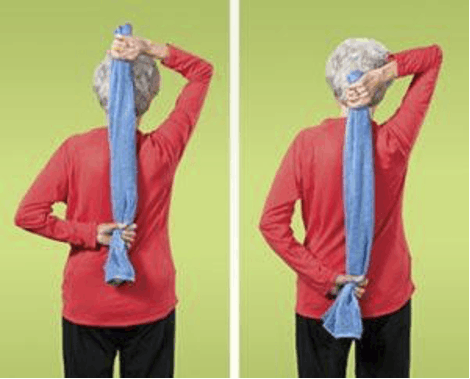Has your physician given you a diagnosis of frozen shoulder? If so, you likely have been experiencing shoulder pain for some time. With this condition, pain tends to come on gradually over a period of 6-9 months. It eventually reaches the point where it becomes so difficult to move one’s shoulder that it actually seems “frozen”. In this post, we will discuss basic shoulder anatomy, how frozen shoulder develops and most importantly, how to resolve the pain, stiffness, and discomfort from this debilitating condition.

Anatomy of the Shoulder
The shoulder joint consists of three separate bones. The upper arm bone (humerus) has a bony knob that fits into the shoulder blade (scapula bone). This forms a ball-and-socket joint. The third bone, known as the clavicle or collarbone, acts as a strut and is attached to both the shoulder blade and the breastbone. Surrounding the area of the shoulder joint is a band of tissue, also known as the shoulder capsule. Synovial fluid also plays an important role in the functioning of the shoulder joint. It provides lubrication to facilitate the movement of all the components that make up the shoulder.
What is Frozen Shoulder?
Frozen shoulder, also referred to as adhesive capsulitis, occurs when the capsule surrounding the shoulder joint thickens and becomes inflamed, gradually prohibiting the free movement of the shoulder area. The capsule begins to form scar tissue and synovial fluid levels fall, both of which hinder shoulder movement even more. The first stage of frozen shoulder begins with the gradual onset of shoulder pain, typically worse during sleep, and lasts for about 6-9 months. The next stage lasts about 4-12 months and is characterized by less pain but more stiffness, making it very difficult to move one’s shoulder.
It isn’t exactly clear what causes frozen shoulder, although middle-aged women, as well as diabetics, seem to be more prone to the condition. It’s very important to receive a proper diagnosis for any shoulder pain because sometimes frozen shoulder can be confused with other medical conditions such as shoulder tendonitis or shoulder bursitis.
How Physical Therapy Helps
Physical therapy can help those experiencing shoulder pain and inflammation through a variety of treatments. Physical therapists typically employ effective treatments such as laser therapy. This helps to reduce the pain, inflammation, and stiffness associated with frozen shoulder. They will also introduce stretching exercises designed to decrease muscle tightness. This will, in turn, increase shoulder mobility. These simple but effective exercises typically become part of a specially designed at-home program, so that patients can continue to work on increasing their range of motion even when not in session with their therapist.
Exercises for Frozen Shoulder
Some of these exercises may include (Codman) Pendulum exercise. This is a gentle exercise where a patient will bend over slightly, then gently swing their arm in a circle. This allows one to introduce a natural motion to the shoulder area without the use of force.

Towel stretches are another good exercise to help increase range of motion. In this exercise, a patient will hold a towel behind their back with each hand. The patient will then gradually lift the towel using their healthy arm and shoulder. This passively bends their affected arm, with the eventual goal of reaching the mid-back region.

You can also try Spider Walks. This exercise is performed by having a patient stand in front of a wall and gradually walking their fingers up the wall, similar to the motion of a crawling spider until their arm is above the shoulder area.
The Active Assisted Supine Flexion stretch is another good stretch. It helps introduce a range of motion to an injured shoulder. In this exercise, starting in a reclined position, the patient will use their healthy arm to gradually move the arm associated with their injured shoulder, up and over their head.

If you have questions about recovering from a Total Shoulder Replacement or would like a Free Consult, call Hess Physical Therapy at any of our 3 convenient locations.
Our locations:
- Kennedy: (412)-771-1055
- Crafton: (412)-458-3445
- Allison Park: (412)-487-2787
- Bethel Park: (412) 835-2626
- Atlasburg: (724) 947-9999
Website: www.hesspt.com
Disclaimer: this information is "not medical advice" and is used at the site visitor's own risk.
